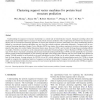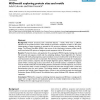WABI
2010
Springer
14 years 3 months ago
2010
Springer
Background: Although many RNA molecules contain pseudoknots, computational prediction of pseudoknotted RNA structure is still in its infancy due to high running time and space con...
NAR
2007
14 years 4 months ago
2007
We present taveRNA, a web server package that hosts three RNA web services: alteRNA, inteRNA and pRuNA. alteRNA is a new alternative for RNA secondary structure prediction. It is ...
BIOINFORMATICS
2000
14 years 4 months ago
2000
Motivation: Evaluating the accuracy of predicted models is critical for assessing structure prediction methods. Because this problem is not trivial, a large number of different as...
BMCBI
2004
14 years 4 months ago
2004
Background: RNA secondary structure prediction methods based on probabilistic modeling can be developed using stochastic context-free grammars (SCFGs). Such methods can readily co...
ESWA
2007
14 years 4 months ago
2007
Understanding the sequence-to-structure relationship is a central task in bioinformatics research. Adequate knowledge about this relationship can potentially improve accuracy for ...
JCC
2008
14 years 4 months ago
2008
: We introduce PULCHRA, a fast and robust method for the reconstruction of full-atom protein models starting from a reduced protein representation. The algorithm is particularly su...
BMCBI
2007
14 years 4 months ago
2007
Background: 3D-Jury, the structure prediction consensus method publicly available in the Meta Server http://meta.bioinfo.pl/, was evaluated using models gathered in the 7th round ...
BMCBI
2006
14 years 4 months ago
2006
Background: One-dimensional protein structures such as secondary structures or contact numbers are useful for three-dimensional structure prediction and helpful for intuitive unde...
BMCBI
2006
14 years 4 months ago
2006
Background: In recent years protein structure prediction methods using local structure information have shown promising improvements. The quality of new fold predictions has risen...
BMCBI
2008
14 years 4 months ago
2008
Background: Protein structures have conserved features


